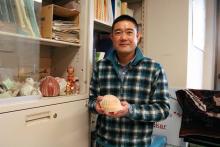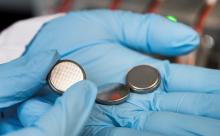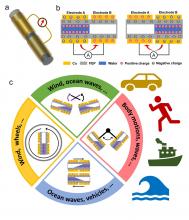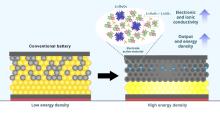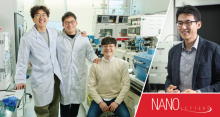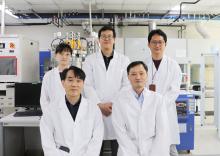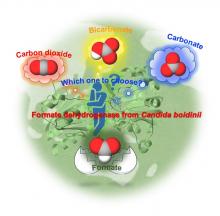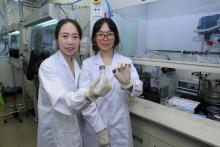Energy
News
05 Apr 2021
“The earth is suffering from several ‘diseases’: global warming, ocean acidification, habitat loss, etc. If any of these diseases remains uncured, other diseases will accelerate and cause new ones to appear, hence putting humanity’s well-being in danger,” said Associate Professor Masahiko Fujii. For this reason, the research staff of the Faculty of Environmental Earth Science keeps on assessing the current global environmental issues and promoting renewable energy sources as a possible solution.
01 Apr 2021
The promotion of electric cars has dramatically increased the demand for lithium-ion batteries. However, cobalt and nickel, the main cathode materials for the batteries, are not abundant. If the consumption continues, it will inevitably elevate the costs in the long run, so scientists have been actively developing alternative materials. A joint research team co-led by a scientist from City University of Hong Kong (CityU) has developed a much more stable, manganese-based cathode material. The new material has higher capacity and is more durable than the existing cobalt and nickel cathode materials - 90% of capacity is retained even when the number of charging-recharging cycles doubled. Their findings shed lights on developing low cost and high efficiency manganese-based cathode materials for lithium-ion batteries.
18 Mar 2021
A research team from the Faculty of Engineering of The Chinese University of Hong Kong (CUHK) has recently developed a water-tube-based triboelectric nanogenerator that can efficiently convert various irregular and low-frequency mechanical energies, including ocean wave energy, into electricity, providing a new avenue for the development of “blue energy”.

10 Mar 2021
Energy-efficient light-emitting diodes (LEDs) have been used in our everyday life for many decades. But the quest for better LEDs, offering both lower costs and brighter colours, has recently drawn scientists to a material called perovskite. A recent joint-research project co-led by the scientist from City University of Hong Kong (CityU) has now developed a 2D perovskite material for the most efficient LEDs.
18 Feb 2021
Lithium ion batteries use liquid electrolytes that have several drawbacks, which can be overcome by all-solid-state lithium secondary batteries (ASSBs). However, it is important to find efficient electrode materials for ASSBs. A research team from Japan has recently developed a novel electrode material for ASSBs by combining lithium sulfate and lithium ruthenate, which results in improved performance. The scientists hope that their novel approach will guide future research and the eventual commercialization of such high-capacity batteries.

11 Feb 2021
ARN's February newsletter features research about catalyzing plastic recycling, the mental health toll of the COVID-19 pandemic, antiperovskites and oolong tea. In honor of International Day of Women and Girls in Science, we also have tips for addressing gender bias in STEM communications, and inspirational stories about pioneering female scientists from our Giants in History series. Read on...
12 Jan 2021
An atomic switch is bringing us closer to highly effective solid-state batteries for electric vehicles.
23 Dec 2020
Scientists at Hokkaido University have developed a layered cobalt oxide with a record-setting thermoelectric figure of merit, which can be used to enhance thermoelectric power generation.
19 Dec 2020
The SNEC 15th (2021) International Photovoltaic Power Generation and Smart Energy Conference will be held on June 2-4, 2021 in Shanghai, China.
09 Dec 2020
Researchers at Hiroshima University in Japan have blended together various polymer and molecular semiconductors as photo-absorbers to create a solar cell with increased power efficiencies and electricity generation.
23 Nov 2020
A chance discovery leads to a simple process that can introduce ‘oxygen-missing layers’ into perovskite oxynitrides, changing their properties.
20 Nov 2020
A research team, affiliated with South Korea's Ulsan National Institute of Science and Technology (UNIST) has recently reported a significant discovery that could bring solar hydrogen production a step closer to reality.
20 Nov 2020
A research team, affiliated with South Korea's Ulsan National Institute of Science and Technology (UNIST) has unveiled a new eco-friendly and low-cost method to synthesize indolopyran, one type of nitrogen ring compound, contained in about 60% of drugs that are recently approved by FDA.
20 Nov 2020
A research team, affiliated with South Korea's Ulsan National Institute of Science and Technology (UNIST) has developed a ‘carbon-based high-efficiency electrochemical catalyst’ for use to produce H2O2.
20 Nov 2020
A research team, affiliated with South Korea's Ulsan National Institute of Science and Technology (UNIST) has developed an electrolyte additive (MA-C60) to reduce the problematic behaviors induced by water contamination and the ROS generated from Li‐rich cathodes.
17 Nov 2020
Scientists explain how selective electrostatic doping can balance the charge in optoelectronic devices with 2D materials
10 Nov 2020
Scientists create a 3D digital “twin” of an all-solid-state battery to visualize its interfacial microstructures in detail
03 Nov 2020
A recent study, affiliated with South Korea's Ulsan National Institute of Science and Technology (UNIST) has developed a new nanocatalyst that recycles major greenhouse gases, such as carbon dioxide (CO2) and methane (CH4), into highly value-added hydrogen (H2) gas.
03 Nov 2020
A recent study, affiliated with South Korea's Ulsan National Institute of Science and Technology (UNIST) has unveiled 2D material-based ultrasensitive surface-enhanced Raman spectroscopy (SERS) sensor by synthesizing uniform large-area ReOxSy thin films.
09 Sep 2020
Scientists at Daegu Gyeongbuk Institute of Science and Technology, Korea, develop a novel “heterostructured” photocatalyst using titanium and copper, two abundant and relatively inexpensive metals. Their cost-effective synthesis procedure, coupled with the high stability of the photocatalyst, provides an economically feasible way to convert waste carbon dioxide and water into useful hydrocarbon fuels using endless sunlight.
04 Sep 2020
Scientists at Daegu Gyeongbuk Institute of Science and Technology (DGIST) in Korea have found a way to improve the efficiency of betavoltaic devices, a type of power source that uses an internal radioactive material. This study opens up a new horizon in the field of nuclear batteries for powering set-and-forget electronic devices.
07 Jul 2020
The JUL 2020 regular issue of the Journal of Humanities & Social Sciences Research (JHSSR), Volume 2 (1) JUL. 2020 has been published ahead of time on 30 Jun 2020 and is now live at the Journal’s webpage.
25 Jun 2020
Most common thin-film solar panels consist of expensive rare-earth elements like indium and gallium, or highly toxic metals like cadmium. Environment-friendly solar panels consisting of the abundant materials Cu, Zn, Sn offer attractive alternatives, but are hindered by their low practical efficiency compared to their theoretical potential. Researchers from DGIST have now discovered a way to overcome these hurdles.
03 Jun 2020
Scientists from the Daegu Gyeongbuk Institute of Science and Technology, Korea, develop a novel silica-based cathode for lithium–sulfur batteries, thereby enabling the realization of batteries that can last for over 2000 charge/discharge cycles. The possibility of successfully using the unconventional silica could spark a paradigm shift in rechargeable battery designs.

28 May 2020
This research focuses on formic acid (HCOOH) (which can be produced from carbon dioxide) as a vehicle to store hydrogen.
This research brings clarity to the mechanism of hydrogen production which has befuddled scientists until now.
27 May 2020
Scientists are unraveling the properties of electricity-conducting plastics so they can be used in future energy-harvesting devices.
18 May 2020
Researchers from Daegu Gyeongbuk Institute of Science and Technology develop a simple approach for controlling the otherwise random formation of cracks in flexible thin-film conductors, greatly increasing the durability of flexible electrodes and transistors against bending and folding.
15 May 2020
The group clarified for the first time whether formate dehydrogenase reduces carbon dioxide, biocarbonate ion, or carbonate ion to formic acid.
Points to a catalyst in developing and designing an artificial photosynthesis system that efficiently converts carbon dioxide into organic molecules.
14 May 2020
A research team led by Prof. Yi-Chun LU from the Faculty of Engineering at The Chinese University of Hong Kong (CUHK) has taken a critical step forward in improving high-energy batteries by introducing a novel electrolyte to the aqueous lithium-ion (Li-ion) battery. This electrolyte is commonly used in skin cream. It is inexpensive, inflammable, less toxic and is eco-friendly, yet can create stable voltage for common usage. The breakthrough was recently published in the world-leading scientific journal, Nature Materials, a sister journal of Nature.
13 May 2020
Hydrogen fuel cells made with coordination polymer glass membranes could produce as much energy as their liquid-based counterparts while adding strength and flexibility.
Events
Sorry, no events coming up for this topic.
Researchers
Sorry, no researchers coming up for this topic.
Giants in history
Julian Arca Banzon (13 March 1908 – 13 September 1988) was a biochemist from the Philippines who was a pioneer in alternative fuel research. Banzon investigated the use of indigenous crops as sources of renewable fuels and chemicals.
Anna Mani (23 August 1918 – 16 August 2001) was an Indian meteorologist who contributed significantly to the understanding of solar radiation, ozone and wind energy by developing a wide range of measurement tools. One of India’s pioneering female scientists, Mani excelled in the male-dominated area of meteorology and became the Deputy Director-General of the India Meteorological Department.


